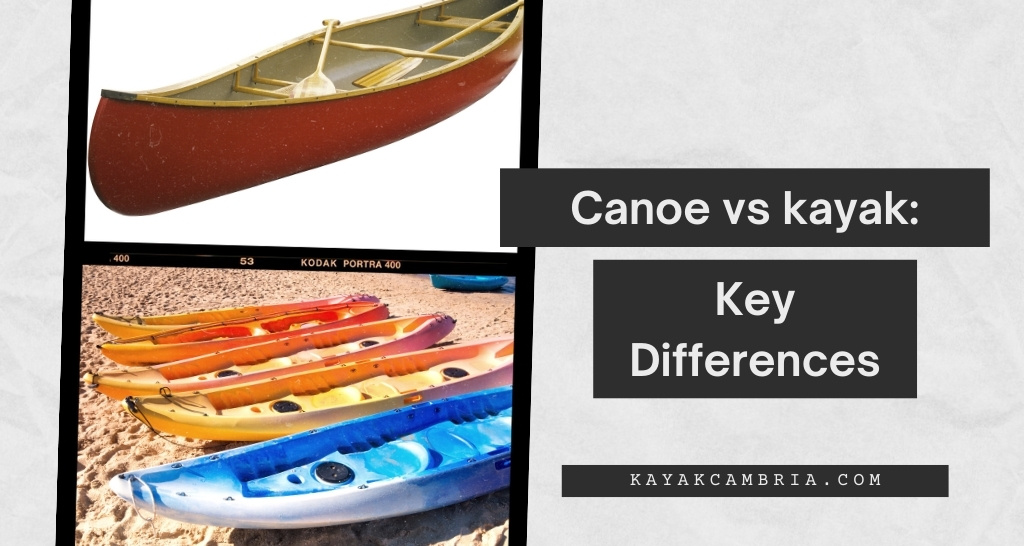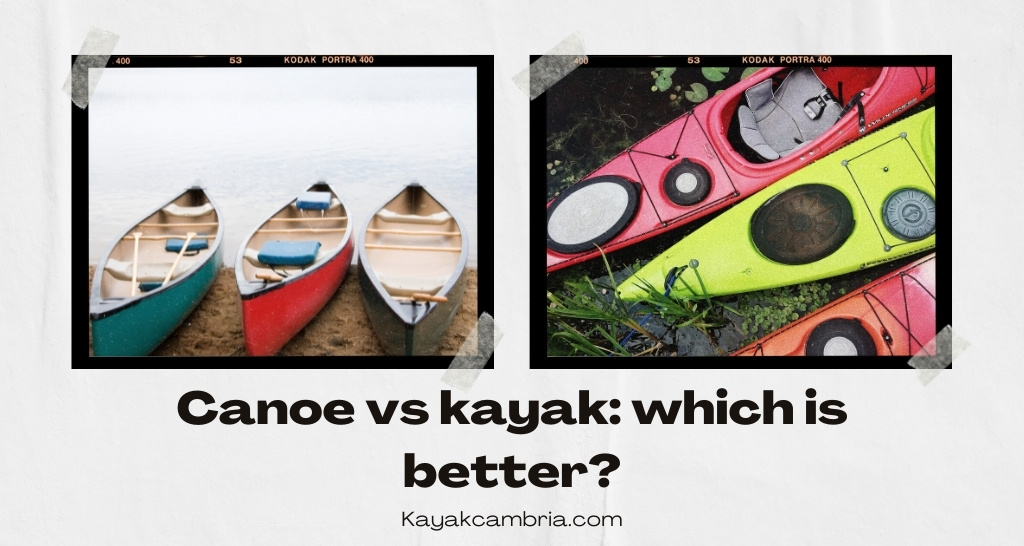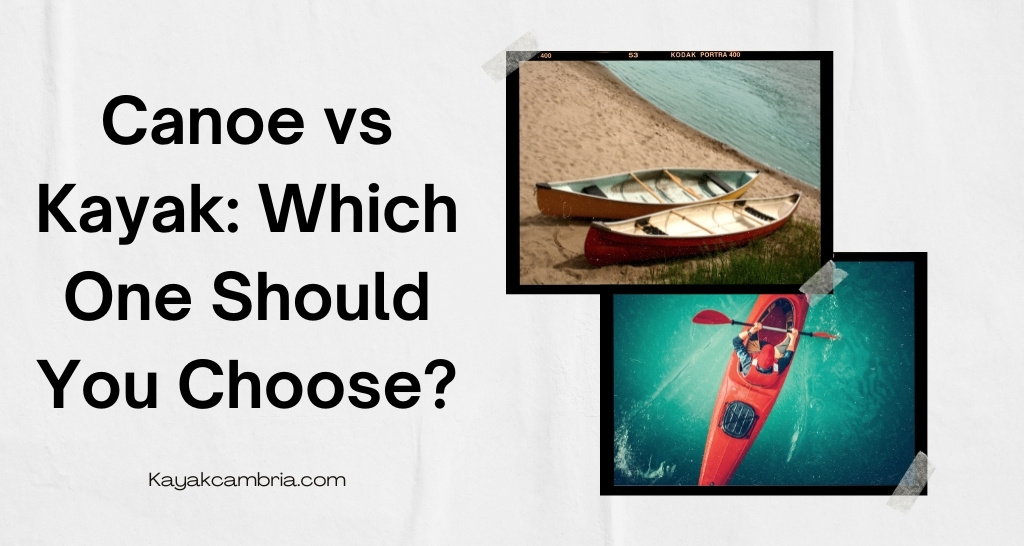The canoe vs kayak debate has been going on since before there were boats. Which one should you choose? There are many factors to consider when choosing a boat, but it’s generally accepted that a canoe is more stable than its counterpart, while the kayak is faster and easier to maneuver. Kayaking is hard on the body and as a result, more difficult to learn. Canoes are best for those who want an affordable boat that’s easy to maneuver in slow-moving waters.
This article will help you make the decision by comparing both canoes and kayaks. We’ll also go over some of the benefits of boating in each type of boat.
Contents
Contents
Canoe vs Kayak: Key Differences
People usually gets confused about the difference between canoe and kayak. But once you learn the difference, you’ll be able to choose the right boat for your next adventure.

So, for you to understand propely I will differentiate both of them as per the following points:
Cockpit
Canoes feature a cockpit, which is an opening at the top of the canoe where you put your feet. This is also called “paddling position.”
Kayaks feature closed cockpits that allow people to paddle on either side and switch sides without having to get out of their seat.
Paddles
In canoes, paddles are typically long and narrow. Kayaks use shorter and wider paddles or blades.
Paddling Stroke
Canoeing uses a J-stroke which is when you move the paddle straight out in front of you to propel yourself forward with each stroke then pull back on the handle at your side.
Kayaking uses a sculling technique in which both hands are used on the paddle to propel yourself forward.
Paddle Length
The size of your paddles affects performance and the type of activity you’re doing with them. When canoeing, it’s important that they be longer when kayaking because you need more power for paddling upstream or in rapids.
When kayaking, a shorter paddle is better because it allows you to maneuver more easily and quickly when paddling downstream or across flat water.
Seat
Canoes usually feature a wooden pad or seat with a strap to keep you securely in place. The canoe does not need straps because it is already stable and doesn’t move around when paddled, like kayaks do.
Kayaks are more difficult to balance on at first but they feature adjustable seats that make the experience easier for new users. You can set them up so your legs, but often feature a thicker and more comfortable seat.
Different Types of Kayak

Recreational kayaks
This type of boat is built for those who love going out on calm waters and enjoy paddling leisurely with friends or family members. Their hull shape makes them a very stable ride in any water conditions even though they are not designed for rough water. They also come with two hatches, which provide storage space for all of your equipment and gear.
Racing kayaks
If you’re a competitive person who enjoys the thrill of racing with others, then this is the best type for you. They have been designed to be as lightweight and sleek as possible so they can move very fast in water conditions that are not too rough. The downside is that these kayaks might not be suitable if you want to use them on a day with choppy waters.
Inflatable kayaks
This Kayak is constructed of a lightweight, durable PVC bladder that’s inflated with air. This Kayak is much easier to transport than a hard-shell kayak. They are also much more affordable.
Touring Kayaks
These kayaks will allow you to go on longer excursions without being cramped up inside the boat. The boats offer more storage space but they can be a bit heavy to carry overland.
Mountain Kayaks
These kayaks are built to tackle difficult rivers and whitewater rapids. They usually have a high-volume bow, which makes them more stable in water conditions that are challenging for other types of kayaks. This type is also made with extra buoyancy foam so you can stay afloat in case of a capsize.
Sea Kayaks
These kayak are made for those who love to go paddling on the open waters and their hull is shaped so that they cut through waves effortlessly. Sea kayaks have enough room inside them for storage, but not as much as touring or recreational kayaks do. They also come with a skeg, which is used to track the kayak’s course.
Touring Kayaks
These kayak are built to withstand the challenge of a rougher waters as they paddle through choppy waves or even surfers who want to take on the next big wave! The cockpit is smaller, which makes it easier to get in and out of the boat quickly. It also has three hatches for storage space.
Different Types of Canoe

Recreational canoe
This canoe is the most common type and it’s made for leisure paddling. It has a much wider hull, which makes them easier to paddle through calmer waters.
Racing canoe
This canoe is designed for speed and they are much narrower than the recreational. It’s also easier to get in and out of as it has two hatches, which makes storage space limited.
Whitewater canoe
These are made for more experienced canoeists who want to paddle through rough waters. It has a very narrow hull, but it’s also much lighter and faster!
Touring canoe
These are faster boats with a narrower beam than recreational canoes so that they can cut through waves more efficiently. They require stronger muscles because of the increased speed and the narrow beam so you’ll need to be strong enough to paddle for hours without tiring.
Canoe vs Kayak: Which is Better?
Now, we know the difference between a canoe and kayak, which is better? Well the answer depends on your skill level. Canoes are easier to maneuver in tight spaces but they’re slower than kayaks. Kayaks can go faster, but it takes more time for them to turn so you need more space when paddling this type of boat

Kayaks and Canoes: Pros and Cons
Kayaks Pros:
- Kayaks are lighter, easier to store and more versatile than canoes.
- Kayak paddles offer a better range of movement; the blades being on two axes as opposed to just one axis in canoeing.
- Kayaks are faster than canoes in flat water, which makes them more suitable for racing.
- Kayak paddles have a smoother motion and require less physical strength to paddle.
- Kayaks are easier to steer than canoes because the blade has a larger surface area.
Kayaks Cons:
- Kayaks are slower than canoes in flat water
- Kayak paddles have a larger surface area, making it easier to get “sucked under” by the current.
- Kayak paddles have less control in a current.
- Kayaks offer less stability than canoes when traveling downstream or on rivers.
Canoes Pros:
- Canoes offer more stability when traveling downstream or on rivers.
- Canoe paddles have a smaller surface area, making it easier to paddle upstream and control the direction of where you’re going.
- Canoes offer less resistance on the water than kayaks do
- Canoes are less expensive to purchase than kayaks.
- Canoes can be used in both freshwater and saltwater
Canoes Cons:
- Canoes are more difficult to transport than kayaks.
- Canoes are harder to steer than kayaks.
- Canoe seats can be uncomfortable and backbreaking after a long stretch of time on water.
- Canoes are heavier than kayaks.
- Canoe seats can be uncomfortable and backbreaking after a long stretch of time on water.
- Once you lean to one side in the canoe, it’s hard to get upright again without flipping over or getting out first.
- Canoes can be really hard to turn around, and it takes a lot of energy.
- Canoes can take up space in your car or truck if you are transporting them on land.
Canoe vs Kayak: Which One Should You Choose?

- If you’re looking for a more stable, sturdy ride on the water and are willing to sacrifice some mobility then opting for a canoe will be your best bet.
- If you want something that is lightweight with easy steering but might take up space in your vehicle when transporting it, kayaks offer an excellent option.
- If you’re looking for something to enjoy in the local waterway or just a day on the river, then either one should work.
- If your primary concern is speed and efficiency, kayaks are going to be your best option.
- Kayaks also offer more storage space than canoes which might benefit those who want their hands free to fish or explore the water.
- If you’re looking for a more social experience, kayaks are probably your best bet as they allow people to face each other and chat while on the water.
- Both canoes and kayaks offer excellent exercise options with canoeing being better suited for longer distances and kayaking being good for shorter distances.
- The main downside to kayaks is their price; they are typically more expensive than canoes and often require a bigger investment if you want one that’s well made.
- If speed, efficiency, or socializing with other people on the water are your primary concerns then we suggest opting for a kayak over a canoe.
Canoe vs Kayak: Conclusion
In conclusion, it depends on your skill level and what you’re trying to achieve. A canoe would be best for newcomers who want a stable boat with more maneuverability than speed while a kayak offers the greatest variety of options in terms of length, weight capacity, as well as the ability to go faster.
The canoe would be best for newcomers who want a stable boat with more maneuverability than speed while a kayak offers the greatest variety of options in terms of length, weight capacity and the ability to go faster. A canoe takes less time than a kayak to turn so you need less space when paddling.

